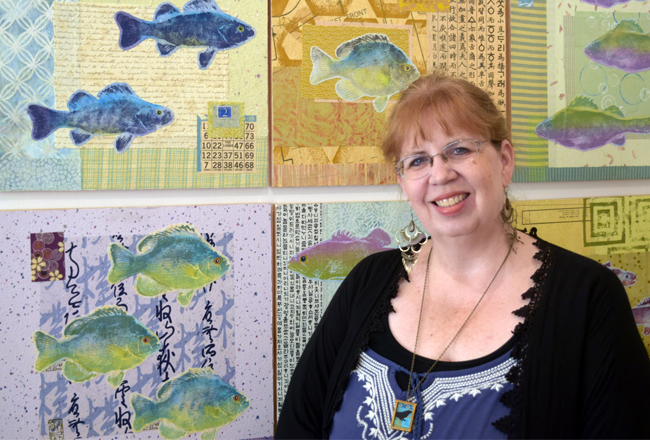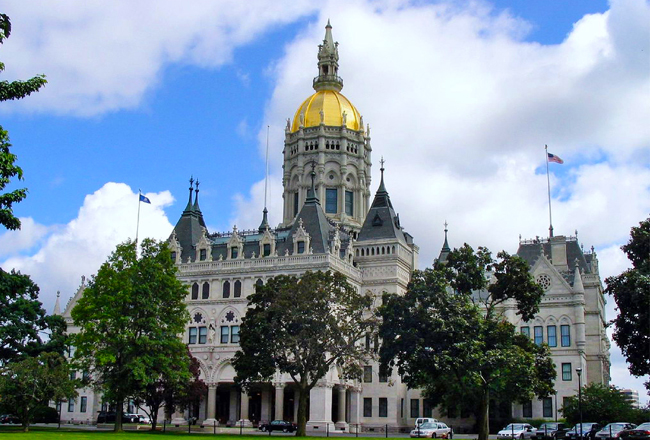
When driving down Bridgeport”™s Fairfield Avenue, it is easy to overlook the NEST Arts Factory. From the outside, it is a nondescript white industrial building with a somewhat incongruous crimson front door and a plain sign identifying what dwells within. But once inside, the building is anything but nondescript.
Spanning 25,000 square feet, the NEST Arts Factory is one of the driving forces in Bridgeport”™s creative community. Originally started in 1996 in the now-defunct Cricket Hosiery Co. factory on Railroad Avenue, NEST Arts Factory is home to 30 studios plus exhibit spaces where the artistic denizens can display their latest creations.
Jane Davila, managing director of the NEST Arts Factory ”” and, also, one of the artists with a studio ”” spoke with Business Journal reporter Phil Hall about the building”™s distinctive place in Bridgeport”™s real estate and artistic scenes.
What was this building before its current incarnation?
“It was built originally in the turn of the last century as a locomobile factory.”
OK, my ignorance is showing ”” what”™s a locomobile?
“That was the precursor to the car, and they used to build the chassis of them here and assemble the vehicle in other places. So, we have a freight elevator that”™s big enough for a car. During World War II, the space was used to manufacture artillery shells ”” the outsides, not the insides. And then it was an aerosol can factory for a long time ”” again, the outsides, not the insides. And now it”™s us. We”™ve been in this building for seven years.”
What does NEST stand for?
“It did stand for something at one point with the original members ”” it stood for Northeast Space Time. But over the last seven years it morphed into the idea of an incubator and a nurturing creative environment.”
How many artists are here and what is the leasing within the space?
“We have 30 studios with 34 artists. Everybody signs a one-year lease for the studios. There is an application on our website, and we have a selection committee for people to meet with. Because it”™s a community, it”™s not like renting an office ”” we need to make sure the person is happy being with us and that we”™re happy with the person.”
What are the studio sizes and rents?
“The range is from just under 100 square feet to just over 750 square feet. The smaller studios start at $200 to $250 (per month), plus utilities and insurance, and go up to $650 to $700 plus utilities and insurance, which is very fair and comparable to what Bridgeport can stand. The front part of the building was the original offices for the factory, which is why the studios there are smaller and have the glass doors. We built out the whole back of the building.”
And what is the turnover rate here?
“For the big studios, almost zero. The smaller studios, we might have four or five a year. There”™s not a huge amount. We advertise when we know space is coming available. But because it”™s about the fit, it”™s not a first come, first serve. We do maintain a waiting list. If we had more big studios, we”™d rent more big studios ”” because that”™s what more people are looking for, bigger space.”
And who are the artists here?
“The artists range in age from just out of art school to 83, so we have a broad range of artists. We have painters and sculptors and printmakers and musicians. We have six musicians in the building ”” one of them has a recording studio that he rents out and the rest use the practice spaces for themselves.”
I see that you also have a gift shop.
“That acts as an opportunity for selling, and it also gives the artists an opportunity to learn about retail sales and merchandising and pricing and creating reproductions.”
So, can anyone just come in here and look around, like in an art gallery?
“Everybody is working, so we have special days when we”™re open to the public. The artists are renting space so they can work, not so they can entertain. We do six to seven open studio events a year. We do the Bridgeport Art Trail, which is always the second weekend in November, and we got about 1,000 people through the building.”
What is the state of Bridgeport”™s art scene?
“It”™s really happening and heating up. There are about 250 working artists in Bridgeport, and we”™ve reached the point that people are being attracted to Bridgeport because there”™s a lot going on. It builds and it builds and it builds until it is like, ”˜Ah, that”™s the place to be, like Brooklyn or SoHo or Chelsea.”™ Bridgeport is getting that reputation to be as a place for art because it”™s not terribly expensive yet. And there are also opportunities to live here as well, which is always good.
We”™ve done artists”™ networking parties here where we have 200 to 250 artists show up and network together. And we do all sorts of collaboration. We did workshops on how to use social media to market yourself and monetize different parts of your career.”
That sense of professional community support sounds very impressive.
“One of the things we offer artists is we do a lot of peer networking and peer-to-peer support. If somebody knows a lot about Instagram, they”™ll share that with other people. If somebody knows sources for materials and supplies, that gets shared. Somebody will poke their head out of the studio and say, ”˜I”™m going to the art supply store downtown, does anybody need anything?”™ So, we are a hive ”” we go to each other”™s opening. It”™s a pretty neat situation.
“We”™ve also hosted the Bridgeport Generation Now group when they held a Civics 101 conference here, so there were a lot of people from the ACLU and city government and people who wanted to be civically engaged who came to this two-day conference. We like to have events here. We have a space for rent ”” either for the civic minded or fine arts minded. We have concerts here all of the time and we have a ballroom dance group that meets here. We also held yoga classes.”
You mentioned opportunities to live in the area. Does NEST play a role in that?
“One of the things we”™re doing is trying to advocate with the city itself. For example, this neighborhood was not a great neighborhood when the NEST moved in. There was a lot of crime, prostitution and all sorts of things going on. Once we were here and it became an active area, the crime moved away.
“What typically happens in arts communities is that the artists move into an area that”™s typically not desirable because you can get a big building inexpensively. After you move in, people start to see how cool it is and what its potential is. And eventually, whoever owns the building wants more money for it because you”™ve shown what its potential could be ”” and the neighbors get upset because a lot of businesses move in and people get priced out.
“Because we”™re not at that point in Bridgeport ”” we”™re just at the point where the artists are moving in ”” we”™re working with the city to find a way to prevent or slow down that type of gentrification so that the artists can stay in the cool buildings and the neighbors don”™t get pushed out when things start lifting up.”






















